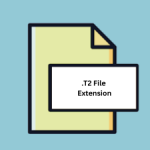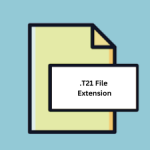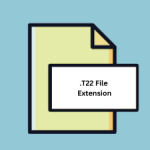.TIE File Extension

CrossTie Installer File
| Developer | Codeweavers |
| Popularity | |
| Category | Data Files |
| Format | .TIE |
| Cross Platform | Update Soon |
What is an TIE file?
The .TIE file extension is associated with CrossTie Installer Files. These files serve as installation scripts or instructions used by software management platforms like CrossOver to facilitate the installation of Windows applications on non-Windows operating systems.
Essentially, .TIE files streamline the process of installing Windows software on platforms such as Linux, macOS, and Android.
More Information.
The concept of CrossTie Installer Files was pioneered by CodeWeavers, a company specializing in compatibility solutions for running Windows software on macOS and Linux systems.
Initially introduced as part of the CrossOver software suite, which facilitates the installation of Windows applications on non-Windows platforms, .TIE files aimed to simplify the process of installing software by encapsulating all necessary configuration data in a single, standardized format.
Origin Of This File.
The concept of .TIE files trace back to the development of CrossOver, a compatibility layer that enables Windows applications to run on Unix-based operating systems, including Linux and macOS.
CodeWeavers, the company behind CrossOver, introduced the CrossTie technology to simplify the installation of Windows software on these platforms.
File Structure Technical Specification.
.TIE files follow a structured format designed to contain pertinent information required for software installation.
This includes details such as the application name, version, installation directory, dependencies, and post-installation tasks.
The format is designed to be platform-agnostic, allowing .TIE files are to be utilized across different operating systems with minimal modifications.
At its core, a .TIE file comprises a combination of XML and script-based elements, providing a flexible framework for describing installation procedures. Key components of the file include:
- Metadata: Contains information about the software application, including its name, version, and publisher.
- Dependencies: Specifies any prerequisite software or libraries required for the application to function properly.
- Installation Steps: Defines the sequence of actions to be executed during the installation process, such as copying files, creating shortcuts, and modifying system settings.
- Post-installation Tasks: Includes any additional actions to be performed after the installation is complete, such as registering components or configuring preferences.
How to Convert the File?
Converting .TIE files entail extracting their contents and executing installation steps manually or through compatible software.
On Windows, users can utilize CrossOver or extract files using archive tools, then execute setup scripts for installation.
Linux users can employ CrossOver/Wine or manually run setup scripts after extraction. Similarly, macOS users can leverage CrossOver for automated conversion or manually extract files and execute setup scripts.
Directly converting .TIE files to Android or iOS formats are challenging due to platform differences. Custom development is necessary to create tailored installation packages for mobile platforms.
For other platforms, like Chrome OS or BSD, custom development may also be required. While direct conversion tools for .TIE files may be limited, but users can effectively convert them by leveraging compatibility layers, manual execution, or custom development efforts to suit various operating systems and platforms.
Advantages And Disadvantages.
Advantage:
- Platform Independence: .TIE files can be used to install software on a wide range of operating systems, including Windows, macOS, and various Linux distributions, making them highly versatile.
- Simplicity: The standardized format of .TIE files simplify the installation process for end-users, eliminating the need for manual configuration or troubleshooting.
- Efficiency: By automating the installation process, .TIE files save time and effort for both developers and end-users, enabling faster deployment of software applications.
- Customization: While .TIE files provide a standardized installation mechanism, they also offer flexibility for developers to customize installation procedures according to specific requirements.
Disadvantage:
- Limited Adoption: Despite their advantages, .TIE files have seen limited adoption outside of specific software ecosystems, which may restrict their usefulness in certain contexts.
- Complexity: While .TIE files simplify the installation process for end-users, creating and managing .TIE files can be complex for developers, especially when dealing with dependencies or platform-specific requirements.
- Maintenance: Keeping .TIE files up-to-date with the latest software versions and compatibility updates requires ongoing maintenance efforts, which can be time-consuming.
- Compatibility Issues: Although designed to be platform-agnostic, .TIE files may encounter compatibility issues with certain operating systems or software configurations, necessitating additional testing and troubleshooting.
How to Open TIE?
Open In Windows
Utilize CrossOver software to directly execute .TIE files on Windows systems. CrossOver provides compatibility for running Windows applications on non-Windows platforms, including the execution of .TIE installer files.
Open In Linux
Install CrossOver or set up Wine on your Linux distribution. These compatibility layers enable running Windows applications on Linux.
Once installed, you can execute the .TIE file directly, initiating the installation process.
Open In MAC
Install CrossOver software on your macOS system. CrossOver facilitates running Windows applications on macOS seamlessly.
Once installed, simply double-click the .TIE file and CrossOver will handle the installation process automatically.
Open In Android
Opening .TIE files on Android are not supported natively. Custom development is required to create installation packages tailored for Android using platform-specific development tools and techniques.
Open In IOS
Opening .TIE files on iOS aren’t supported. Custom development is needed to adapt the files for mobile platforms like iOS, creating installation packages through platform-specific development tools.
Open in Others
For platforms beyond Windows, Linux, macOS, Android, and iOS, custom development or adaptation may be necessary.
This could involve creating custom scripts or tools to interpret .TIE files and executes the installation steps on the respective platforms.













